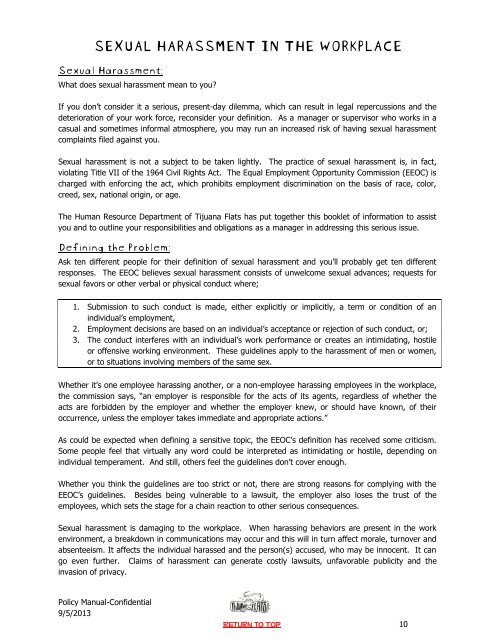Policy Manual 9.2013 - Tijuana Flats
Policy Manual 9.2013 - Tijuana Flats
Policy Manual 9.2013 - Tijuana Flats
You also want an ePaper? Increase the reach of your titles
YUMPU automatically turns print PDFs into web optimized ePapers that Google loves.
SEXUAL HARASSMENT IN THE WORKPLACESexual Harassment:What does sexual harassment mean to you?If you don’t consider it a serious, present-day dilemma, which can result in legal repercussions and thedeterioration of your work force, reconsider your definition. As a manager or supervisor who works in acasual and sometimes informal atmosphere, you may run an increased risk of having sexual harassmentcomplaints filed against you.Sexual harassment is not a subject to be taken lightly. The practice of sexual harassment is, in fact,violating Title VII of the 1964 Civil Rights Act. The Equal Employment Opportunity Commission (EEOC) ischarged with enforcing the act, which prohibits employment discrimination on the basis of race, color,creed, sex, national origin, or age.The Human Resource Department of <strong>Tijuana</strong> <strong>Flats</strong> has put together this booklet of information to assistyou and to outline your responsibilities and obligations as a manager in addressing this serious issue.Defining the Problem:Ask ten different people for their definition of sexual harassment and you’ll probably get ten differentresponses. The EEOC believes sexual harassment consists of unwelcome sexual advances; requests forsexual favors or other verbal or physical conduct where;1. Submission to such conduct is made, either explicitly or implicitly, a term or condition of anindividual’s employment,2. Employment decisions are based on an individual’s acceptance or rejection of such conduct, or;3. The conduct interferes with an individual’s work performance or creates an intimidating, hostileor offensive working environment. These guidelines apply to the harassment of men or women,or to situations involving members of the same sex.Whether it’s one employee harassing another, or a non-employee harassing employees in the workplace,the commission says, “an employer is responsible for the acts of its agents, regardless of whether theacts are forbidden by the employer and whether the employer knew, or should have known, of theiroccurrence, unless the employer takes immediate and appropriate actions.”As could be expected when defining a sensitive topic, the EEOC’s definition has received some criticism.Some people feel that virtually any word could be interpreted as intimidating or hostile, depending onindividual temperament. And still, others feel the guidelines don’t cover enough.Whether you think the guidelines are too strict or not, there are strong reasons for complying with theEEOC’s guidelines. Besides being vulnerable to a lawsuit, the employer also loses the trust of theemployees, which sets the stage for a chain reaction to other serious consequences.Sexual harassment is damaging to the workplace. When harassing behaviors are present in the workenvironment, a breakdown in communications may occur and this will in turn affect morale, turnover andabsenteeism. It affects the individual harassed and the person(s) accused, who may be innocent. It cango even further. Claims of harassment can generate costly lawsuits, unfavorable publicity and theinvasion of privacy.<strong>Policy</strong> <strong>Manual</strong>-Confidential9/5/2013Return to Top 10


